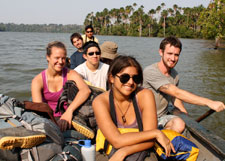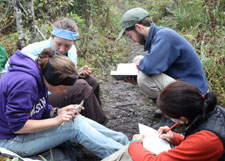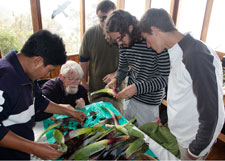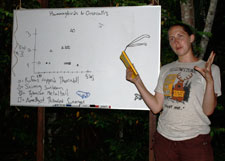|
Exploration Seminars Take Students Around the World
By Ursula Valdez and Tim Billo, with an introduction by Biology Chair Ray Huey
Introduction
I can proudly say that graduate students in our department are among the most accomplished and energetic group on campus. Not only are they conducting fascinating and top quality research on virtually every continent of the globe, they are also recognized for their outstanding teaching and outreach work and have won significant awards for their contributions to undergraduate learning at the UW. In keeping with this tradition, Biology graduate students Ursula Valdez and Tim Billo recently designed and taught a field biology course in Peru.
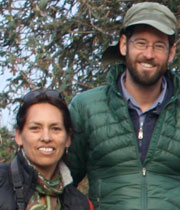 |
| Ursula Valdez & Tim Billo |
Ursula and Tim have spent much of the last five years working in the Neotropics on their dissertation projects (Ursula studying raptors in the Peruvian Amazon; Tim studying two species of passerine birds in Panama). They both attribute extensive field biology experiences as undergrads to their decisions to pursue science today. Unfortunately field experiences are becoming increasingly rare in college education. So when the chance arose through the UW Exploration Seminar Program to develop a field course in which they could share their passion for tropical biology with undergraduates, they took it. What follows is their account of this course. I hope you enjoy reading it as much as I did.—Professor Ray Huey
Exploring the Peruvian Andes and Amazon
In the summer of 2008, with the help of our faculty sponsor, Professor Emeritus John Edwards, we led the UW Exploration Seminar “Biodiversity, Conservation and Sustainability: From Andes to Amazon” for 20 enthusiastic UW undergraduates and two Peruvian undergraduates. In this course students were educated in ecological field techniques for the study of biodiversity, beginning with basic natural history and taxonomy. Along the way, students learned about traditional and non-traditional uses of natural resources and were exposed to pressing conservation issues facing the region. For 21 days students and instructors lived and breathed biology!
|
|
Left: Peruvian student Veronica Rubinos and UW undergrads Nate Schmidt, Lindsey Fenner, Jason Yu, and Matt Warren spot Giant River Otters while boating on Lake Sandoval. Right: UW undergrads Alexandra Troiano and Elizabeth Smith take measurements of captured birds while Ursula and Tim (at right) record data.
|
The course assembled in the historic city of Cusco, the ancient capital of the Inca Empire, set at 10,000 ft. in the arid Andes. In the productive Urubamba Valley, students discussed traditional, organic, and non-organic agricultural practices and surveyed the diversity of crops represented in the local market. At a women’s cooperative, students learned hands on—literally—traditional wool dyeing techniques and identified the plant and animal species used as natural colorants. We visited Machu Picchu where we discussed historical relationships between the Inca civilization and nature, the domestication of native plants, the biological diversity of the area, and the effects of present day tourism on surrounding ecosystems.
|
|
Left: Professor Emeritus John Edwards (seated), UW undergrads Brian Feldman, Robby Mohr and Daniel Parker (on right), and Peruvian student Cesar Medina dissect an epiphytic bromeliad, inside which they discover numerous invertebrate species. Right: Undergrad Emily Cordz presents findings of her research.
|
One of the most important aspects of the program was that it gave students the opportunity to apply scientific thinking and hypothesis testing on site. For 16 days, students worked in rustic conditions in two fairly unexplored field stations: Wayqecha in the cloud forest of Manu Biosphere Reserve, and CECCOT in the Amazonian rainforest of the Tambopata River. Under our guidance and armed with field guides, binoculars, mistnets, insect nets and vials, mammal and amphibian traps, measuring and diameter tapes, students designed a variety of short group projects. The multidisciplinary nature of the group contributed to the students’ success with these projects. Here are just a few of the creative projects that students designed and executed:
- Daniel Parker (Anthropology) and Peruvian student Cesar Medina investigated invertebrate species diversity in the aquatic microhabitats within epiphytic bromeliads, discovering that each bromeliad is practically its own ecosystem. They identified myriad invertebrate species and a recently described, rare frog species, potentially identifying its breeding habitat!
- Alexandra Troiano (Fisheries) and Elizabeth Smith (Biology) investigated wing size to body mass ratios of hummingbirds along the altitudinal gradient.
- Sophie Pierszalowski (Biology), Tauna Shoemaker (Social Welfare), Angelica Corral (Biology) and Somer Kreisman (Photography) designed and implemented environmental education activities for a group of primary school students.
- Dawn Wiltzius (Biology) worked with local students planting an organic vegetable garden, both as a source of food for the field station, and as a demonstration project for the local community.
- Robby Mohr (pre-major) spearheaded a project on the abundance and distribution of amphibian species in CECCOT, and developed the first picture guide to the species for this site.
- Lindsey Fenner and Korrin Keyser (both Biology) looked at factors affecting the composition and distribution of epiphytic plant communities at Wayqecha.
Because tropical conservation and loss of biodiversity were a central theme of the program, we ensured that the ecological impact of our group was minimized in every way possible without compromising the quality of the experience. Reducing the ecological impact of the group became one of the most important learning experiences for all participants. A group of students took the lead and designed a simple and practical way to measure the impacts of the activities at the individual and group level. Students tracked and quantified individual activities on a daily basis and reduced impacts wherever possible as the course progressed. At the end of the trip, individual and group impacts were quantified to assess the course’s total ecological impact. This impact assessment is now serving as a model for new UW exploration seminars going out all over the world this year.
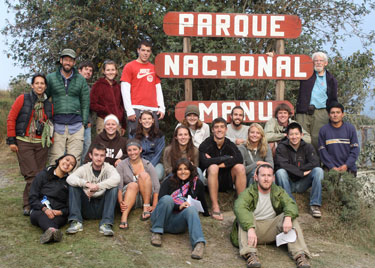 |
| Ursula and Tim (top left), John Edwards (top right), and students at the highest mountain pass (ca. 12,000 feet) in Manu National Park, Peru. |
Afterward
The Exploring the Peruvian Andes and Amazon Exploration Seminar received highly positive student evaluations, so Ursula and Tim will offer it again in 2009, this time joined by Eileen O’Connor as their faculty sponsor. At the end of this coming summer, they will take another 20 students to Peru for another unforgettable experience. For more information about their Exploration Seminar, please visit:
http://depts.washington.edu/explore/programs/2009/peru.htm
http://students.washington.edu/timbillo/index.shtml
* Photos by Ursula Valdez
|


